Three-Dimensional Heterogeneity of the Pore and Fracture Development and Acoustic Emission Response Characteristics of Coal Rocks in the Yunnan Laochang Block
Abstract
:1. Introduction
2. Sample Collection and Methods
2.1. Experimental Samples
2.2. CT Scan Test
2.3. Coal Rock Compression and Acoustic Emission Tests
3. Analysis of the Coal Rock Pore and Fracture Structure
3.1. Three-Dimensional Reconstruction of the Coal Rock Based on Avizo
3.2. Characteristics of the Coal Rock Pore and Fracture Development
3.2.1. Distinguishing between the Pore and Fracture
3.2.2. Distribution and Percentage of the Pores and Fractures
3.2.3. Number and Average Volume of the Pores and Fractures
3.2.4. Void Size Distribution
4. Compressive Properties and Acoustic Emission Characteristics of the Coal Rock
4.1. Analysis of the Stress–Strain Curve of the Coal Rock
4.2. Coal Rock Acoustic Emission Characteristics
4.3. Determination of the Kaiser Effect Point for Acoustic Emission
4.4. In Situ Stress Calculation Using the Acoustic Emission
5. Acoustic Emission Response of Heterogeneity in the Pores and Fractures of Coal Rocks
5.1. Impact of Coal Rock Pore and Fracture Development on the Acoustic Emission Characteristics
5.2. Impact of Large Fractures on Acoustic Emission Counts
6. Conclusions
- (1)
- In the direction of the vertical stratification plane, the greatest concentration of core voids can be observed, accompanied by the formation of large and densely packed pores and fractures. On the parallel stratification plane, a high percentage of core voids are oriented at 45° to the face cleat, accompanied by numerous minuscule pores and fractures; the percentage of core voids running parallel to the face cleat is comparatively low, with a moderate count of pores and fractures that are generally small in volume; the core voids oriented vertically to the face cleat have the lowest percentage and count, yet the average volume of these pores and fractures are relatively large. The analysis of the pore diameter distribution and fracture length reveals that the majority of pores and fractures within the core are of the smaller variety.
- (2)
- The coal rock acoustic emission process examined in this study can be roughly divided into three phases. The first phase is characterized by a comparatively high accumulative count and strength of acoustic emissions. Following this, the second phase exhibits a noticeable lull, marked by a decrease in the frequency and strength of acoustic emissions. The third phase emerges as the peak period for acoustic emission, producing numerous high-strength acoustic emission events.
- (3)
- The acoustic emission characteristics of the coal rock samples are correlated with the original structure, and the higher the percentage of voids, the higher the acoustic emission signal strength, whereas the cumulative acoustic emission counts are not only influenced by the proportion of voids but also by the development of large fractures. The presence of large fractures significantly increases the accumulative acoustic emission counts and also results in a lower modulus of elasticity of the coal rock.
- (4)
- Kaiser effect points are identified based on a comprehensive analysis of the acoustic emission accumulative counts and signal strength. The vertical in situ stress is 4.19 MPa, the maximum horizontal principal stress is 6.62 MPa, and the minimum horizontal principal stress is 3.12 MPa, corresponding to a strike-slip type of stress field. The predictions made regarding the stress field type based on the acoustic emission method align closely with the drilling data, confirming the accuracy and reliability of the study.
Author Contributions
Funding
Data Availability Statement
Acknowledgments
Conflicts of Interest
References
- Liu, B.; Ji, C.; Guo, H.; Zhai, J.; Tang, S.; Zhang, S. Origin and Productivity Response of Gas and Water in Coalbed Methane Field of Yuwang Block at Laochang, Yunnan Province. Geoscience 2022, 36, 1341–1350. [Google Scholar] [CrossRef]
- Wang, J.; Li, J.; Li, Q.; Chen, W.; Xue, X.; Cai, Y.; Chen, Z. Geological Conditions and Resource Potential of Coalbed Methane Reservoirs in Laochang Mining Area, Yunnan Province. Geoscience 2022, 36, 1351–1359. [Google Scholar] [CrossRef]
- Zhang, S.; Wu, C.; Liu, H. Comprehensive characteristics of pore structure and factors influencing micropore development in the Laochang mining area, eastern Yunnan, China. J. Pet. Sci. Eng. 2020, 190, 107090. [Google Scholar] [CrossRef]
- Zhang, Z.; Qin, Y.; Wang, G.; Sun, H.; You, Z.; Jin, J.; Yang, Z. Evaluation of Coal Body Structures and Their Distributions by Geophysical Logging Methods: Case Study in the Laochang Block, Eastern Yunnan, China. Nat. Resour. Res. 2021, 30, 2225–2239. [Google Scholar] [CrossRef]
- Yang, Z.B.; Li, Y.Y.; Qin, Y.; Sun, H.S.; Zhang, P.; Zhang, Z.G.; Wu, C.C.; Li, C.L.; Chen, C.X. Development unit division and favorable area evaluation for joint mining coalbed methane. Pet. Explor. Dev. 2019, 46, 583–593. [Google Scholar] [CrossRef]
- Cheng, Z.; Ning, Z.; Zhao, H.; Wang, Q.; Zeng, Y.; Wu, X.; Qi, R.; Zhang, S. A comprehensive characterization of North China tight sandstone using micro-CT, SEM imaging, and mercury intrusion. Arab. J. Geosci. 2019, 12, 407. [Google Scholar] [CrossRef]
- Peng, J.; Sun, N.; Lu, K.; Xu, Y.; Chen, F. Shale oil reservoir of the Palaeogene Shahejie Formation in the Dongpu Sag: Petrology and pore microstructural characteristics. Earth Sci. Front. 2023, 30, 128–141. [Google Scholar] [CrossRef]
- Guo, C.; Wang, X.; Wang, H.; He, S.; Liu, H.; Zhu, P. Effect of pore structure on displacement efficiency and oil-cluster morphology by using micro computed tomography (μCT) technique. Fuel 2018, 230, 430–439. [Google Scholar] [CrossRef]
- Li, W.; Yao, H.; Liu, H.; Kang, Z.; Song, X.; Feng, Z. Advanced characterization of three-dimensional pores in coals with different coal-body structure by micro-CT. J. China Coal Soc. 2014, 39, 1127–1132. [Google Scholar] [CrossRef]
- Pant, L.M.; Huang, H.; Secanell, M.; Larter, S.; Mitra, S.K. Multi scale characterization of coal structure for mass transport. Fuel 2015, 159, 315–323. [Google Scholar] [CrossRef]
- Zhang, G.; Ranjith, P.G.; Perera, M.S.A.; Haque, A.; Choi, X.; Sampath, K.S.M. Characterization of coal porosity and permeability evolution by demineralisation using image processing techniques: A micro-computed tomography study. J. Nat. Gas Sci. Eng. 2018, 56, 384–396. [Google Scholar] [CrossRef]
- Jia, Z.; Xie, H.; Zhang, R.; Li, C.; Wang, M.; Gao, M.; Zhang, Z.; Zhang, Z. Acoustic Emission Characteristics and Damage Evolution of Coal at Different Depths Under Triaxial Compression. Rock Mech. Rock Eng. 2020, 53, 2063–2076. [Google Scholar] [CrossRef]
- Lisjak, A.; Liu, Q.; Zhao, Q.; Mahabadi, O.K.; Grasselli, G. Numerical simulation of acoustic emission in brittle rocks by two-dimensional finite-discrete element analysis. Geophys. J. Int. 2013, 195, 423–443. [Google Scholar] [CrossRef]
- Chen, S.; Yin, D.; Jiang, N.; Wang, F.; Zhao, Z. Mechanical properties of oil shale-coal composite samples. Int. J. Rock Mech. Min. Sci. 2019, 123, 104120. [Google Scholar] [CrossRef]
- Liu, X.; Liu, Z.; Li, X.; Gong, F.; Du, K. Experimental study on the effect of strain rate on rock acoustic emission characteristics. Int. J. Rock Mech. Min. Sci. 2020, 133, 104420. [Google Scholar] [CrossRef]
- Rodríguez, P.; Celestino, T.B. Application of acoustic emission monitoring and signal analysis to the qualitative and quantitative characterization of the fracturing process in rocks. Eng. Fract. Mech. 2019, 210, 54–69. [Google Scholar] [CrossRef]
- Momayez, M.; Hassuni, E.P. Application of Kaiser Effect to measure in-situ stresses in underground mines. In Proceedings of the 33rd U.S. Symposium on Rock Mechanics (USRMS), Santa Fe, New Mexico, 3–5 June 1992. ARMA–92-0979. [Google Scholar]
- Lavrov, A. The Kaiser effect in rocks: Principles and stress estimation techniques. Int. J. Rock Mech. Min. Sci. 2003, 40, 151–171. [Google Scholar] [CrossRef]
- Mandai, J.; Tao, L.I.U. Study on stress distribution law of in Xiaochangba mining area based on Kaiser effect. China Min. Mag. 2019, 28, 161–165. [Google Scholar] [CrossRef]
- Bai, X.; Zhang, D.-M.; Wang, H.; Li, S.-J.; Rao, Z. A novel in situ stress measurement method based on acoustic emission Kaiser effect: A theoretical and experimental study. R. Soc. Open Sci. 2018, 5, 181263. [Google Scholar] [CrossRef]
- Zhang, N.; Lan, H.; Li, L.; Sun, W.; Liu, S.; Lin, G.; Tian, C. Characteristics and Implications of In-Situ Stresses in Southeastern Tibetan Plateau. J. Eng. Geol. 2022, 30, 696–707. [Google Scholar] [CrossRef]
- Fang, X.; Wu, C.; Liu, X.; Zhang, S.; Liu, N. Productivity characteristics and influencing factors of coalbed methane wells in Yuwang block of Laochang mining area in eastern Yunnan and western Guizhou provinces. J. Henan Polytech. Univ. (Natual Sci.) 2020, 39, 11–16. [Google Scholar] [CrossRef]
- GB/T 212-2008; Proximate analysis of coal. General Administration of Quality Supervision, Inspection and Quarantine of the People’s Republic of China. Standardization Administration of the People’s Republic of China: Beijing, China, 2008.
- Wang, Z.; Qin, Y. Physical experiments of CBM coproduction: A case study in Laochang district, Yunnan province, China. Fuel 2019, 239, 964–981. [Google Scholar] [CrossRef]
- Liu, S.; Huang, Z. Exploration of microstructure characteristics and mechanical behaviors of thermal-damaged argillaceous sandstone via LF-NMR and µ-CT technologies. Geomech. Geophys. Geo-Energy Geo-Resour. 2023, 9, 27. [Google Scholar] [CrossRef]
- Wang, Z.; Shi, Y.; Pan, M.; Wang, H.; Ma, Z. Mineralogical Mechanism of Micro-Remaining Oil Occurrence: An Example Study of Middle-Low Permeability Sandstone Reservoir of Ordos Basin. Acta Sci. Nat. Univ. Pekin. 2021, 57, 111–120. [Google Scholar]
- Li, X.; Lu, Y.; Zhang, X.; Fan, W.; Lu, Y.; Pan, W. Quantification of macropores of Malan loess and the hydraulic significance on slope stability by X-ray computed tomography. Environ. Earth Sci. 2019, 78, 522. [Google Scholar] [CrossRef]
- Zhu, Y.; Tan, Y.; Zhang, S.; Wang, M.; Wang, B. Dynamic Evolution and Quantitative Characterization of Fractures in Coal at the Eastern Edge of Ordos Basin under Axial Loading. Processes 2023, 11, 1631. [Google Scholar] [CrossRef]
- Mo, Z.; Qian, L.; Yao, T.; Gao, Y.; Zhang, J.; Zhang, R.; Liu, E.; Jiang, H. Stress Threshold Determination Method and Damage Evolution Modelling Based on Micritic Bioclastic Limestone. Rock Mech. Rock Eng. 2024, 57, 45–60. [Google Scholar] [CrossRef]
- Tang, M.; Wang, G.; Chen, S.; Yang, C. Crack initiation stress of brittle rock with different porosities. Bull. Eng. Geol. Environ. 2021, 80, 4559–4574. [Google Scholar] [CrossRef]
- Qian, L.; Yao, T.; Mo, Z.; Gao, Y.; Zhang, J.; Li, Y.; Zhang, R.; Li, Z. Experimental study on crack evolution behavior and constitutive model of granite based on the deviatoric stress to peak strength ratio. Bull. Eng. Geol. Environ. 2022, 81, 278. [Google Scholar] [CrossRef]
- Jiang, G.; Zuo, J.; Li, Y.; Wei, X. Experimental Investigation on Mechanical and Acoustic Parameters of Different Depth Shale Under The Effect of Confining Pressure. Rock Mech. Rock Eng. 2019, 52, 4273–4286. [Google Scholar] [CrossRef]
- Cheng, C.; Xue, S.; Han, Y. Experimental Study on the Mechanical Behavior of Coal under Triaxial Dynamic Compression. Minerals 2022, 12, 1206. [Google Scholar] [CrossRef]
- Chen, S.; Zhu, Y.; Wang, H.; Liu, H.; Wei, W.; Fang, J. Shale gas reservoir characterisation: A typical case in the southern Sichuan Basin of China. Energy 2011, 36, 6609–6616. [Google Scholar] [CrossRef]
- Hui, G.; Chen, Z.; Wang, Y.; Zhang, D.; Gu, F. An integrated machine learning-based approach to identifying controlling factors of unconventional shale productivity. Energy 2023, 266, 126512. [Google Scholar] [CrossRef]
- Xing, Y. Study on the Removability of Multi-Layer Stacked Coal Reservoir in Laochang Block of Eastern Yunnan. Master’s Thesis, China University of Geosciences, Beijing, China, 2020. [Google Scholar]
- Xiaohan, Q.; Shuangrong, H.; Heng, M.; Pin, W.; Yang, L.; Xiangming, Z. Research on Triaxial Test of Coal Rock Mechanics Based on Graphical Measurement Technology. Chin. Q. Mech. 2023, 44, 739–749. [Google Scholar] [CrossRef]
- Lockner, D. The role of acoustic-emission in the study of rock fracture. Int. J. Rock Mech. Min. Sci. 1993, 30, 883–899. [Google Scholar] [CrossRef]
- Zhao, K.; Yang, D.; Gong, C.; Zhuo, Y.; Wang, X.; Zhong, W. Evaluation of internal microcrack evolution in red sandstone based on time–frequency domain characteristics of acoustic emission signals. Constr. Build. Mater. 2020, 260, 120435. [Google Scholar] [CrossRef]
- Meng, Q.; Zhang, M.; Han, L.; Pu, H.; Nie, T. Effects of Acoustic Emission and Energy Evolution of Rock Specimens Under the Uniaxial Cyclic Loading and Unloading Compression. Rock Mech. Rock Eng. 2016, 49, 3873–3886. [Google Scholar] [CrossRef]
- Liu, S.; Li, X.; Wang, D.; Wu, M.; Yin, G.; Li, M. Mechanical and Acoustic Emission Characteristics of Coal at Temperature Impact. Nat. Resour. Res. 2020, 29, 1755–1772. [Google Scholar] [CrossRef]
- Wang, H.; Zhao, F.; Huang, Z.; Yu, H.; Niu, J.; Zhang, P. Study on acoustic emission characteristics of sandstone under different fracture modes. Arab. J. Geosci. 2018, 11, 772. [Google Scholar] [CrossRef]
- Gao, B.; Qian, Y.; Lv, P. Study on failure mechanics and acoustic emission characteristics of coal sample under loading rate. Chin. J. Undergr. Space Eng. 2020, 16, 463–474. [Google Scholar]
- Zhang, X.; Fu, X.; Shen, Z.; Huang, X. Study on the method of in-situ stress measurement with Kaiser effect of rock acoustic emission. China Meas. Test 2017, 43, 18–23. [Google Scholar] [CrossRef]
- Kui, Z.; Dao-Quan, Y.A.N.; Chun-Hui, Z.; Xue-Yi, Z.H.I.; Xiao-Jun, W.; Xue-Qiang, X. Comprehensive analysis method and experimental vertification for in-situstress measurement by acoustic emission tests. Chin. J. Geotech. Eng. 2012, 34, 1403–1411. [Google Scholar]
- Ebrahimian, Z.; Ahmadi, M.; Sadri, S.; Li, B.Q.; Moradian, O. Wavelet analysis of acoustic emissions associated with cracking in rocks. Eng. Fract. Mech. 2019, 217, 106516. [Google Scholar] [CrossRef]
- Zhengjun, H.; Lei, Z.; Yu, L.; Dong, Z. Experimental Test for Geostress by Accepting the kaiser Effect under Confining Pressure Conditions. Res. Explor. Lab. 2018, 37, 68–71. [Google Scholar]
- Jingen, D.; Kangping, W.; Rongzun, H. In-situ stress determination at great depth by using acoustic emission technique. In Proceedings of the 35th U.S. Symposium on Rock Mechanics (USRMS), Reno, NV, USA, 5–7 June 1995. [Google Scholar]
- Zhao, J.; Gao, Y.; Chen, Z.; Guo, T.; Gao, X. Stress state of deep seam and its influence on development performance of CBM wells in South Yanchuan Block, Odors Basin. Geol. China 2021, 48, 785–793. [Google Scholar] [CrossRef]
- Ju, W.; Jiang, B.; Qin, Y.; Wu, C.; Wang, G.; Qu, Z.; Li, M. The present-day in-situ stress field within coalbed methane reservoirs, Yuwang Block, Laochang Basin, south China. Mar. Pet. Geol. 2019, 102, 61–73. [Google Scholar] [CrossRef]
- Guo, Y.-X.; Zhao, Y.-H.; Wang, S.-W.; Feng, G.-R.; Zhang, Y.-J.; Ran, H.-Y. Stress-strain-acoustic responses in failure process of coal rock with different height to diameter ratios under uniaxial compression. J. Cent. South Univ. 2021, 28, 1724–1736. [Google Scholar] [CrossRef]
- Zhao, Z.; Jing, H.; Shi, X.; Wu, J.; Yin, Q. Experimental investigation on fracture behaviors and acoustic emission characteristics of sandstone under different strain rates. Environ. Earth Sci. 2021, 80, 85. [Google Scholar] [CrossRef]
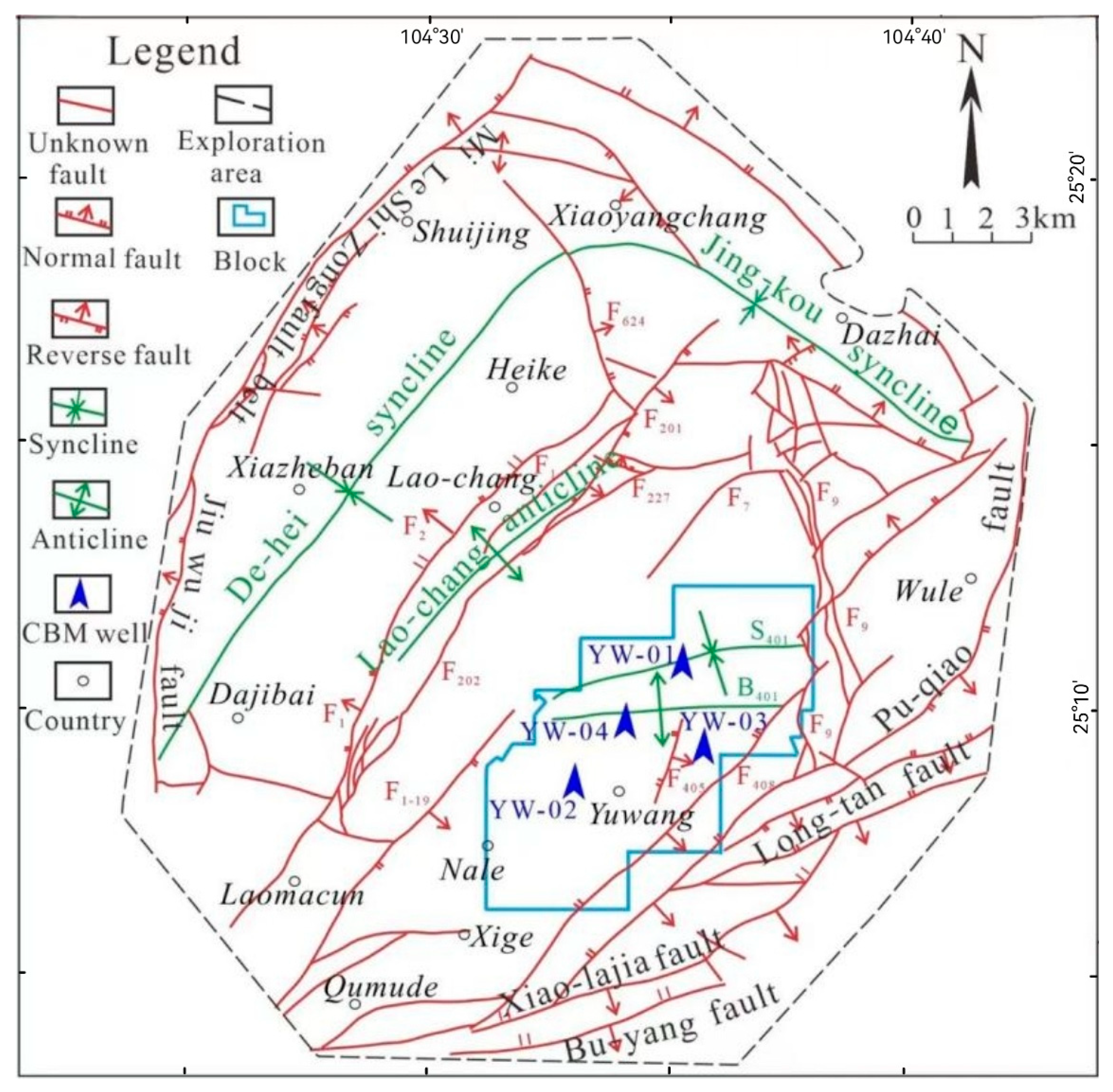
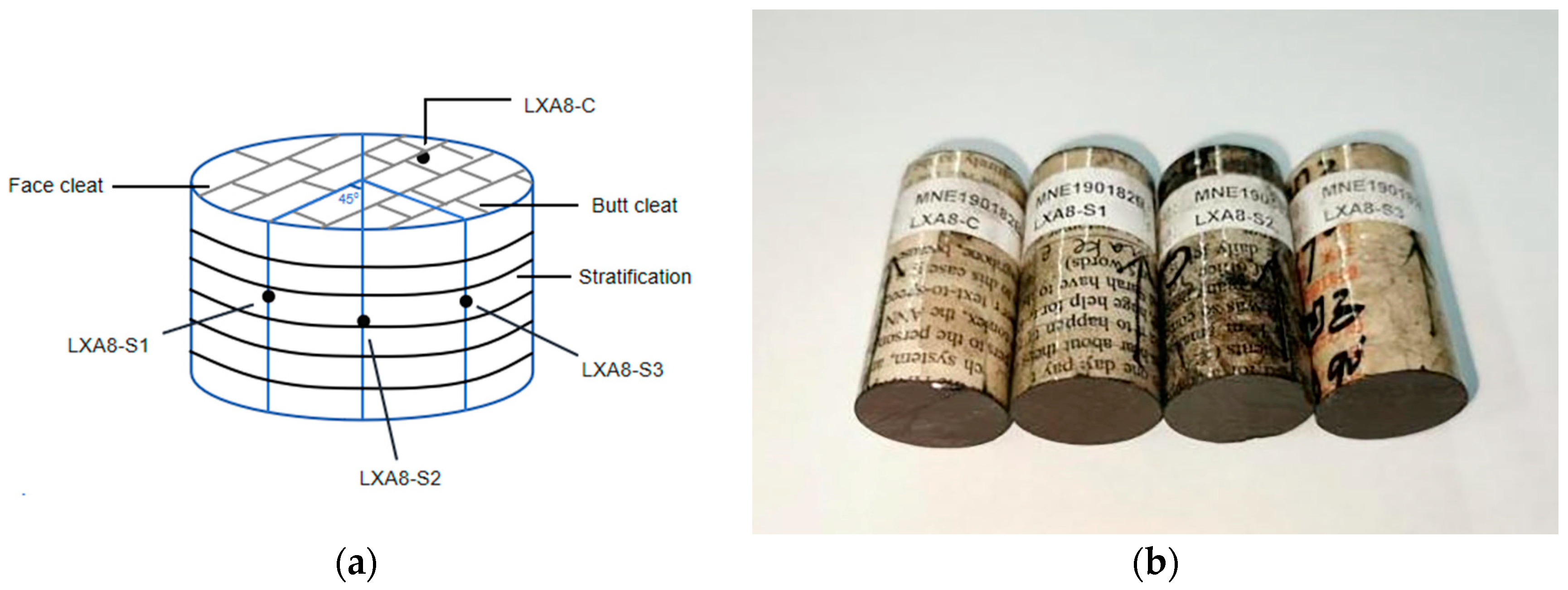


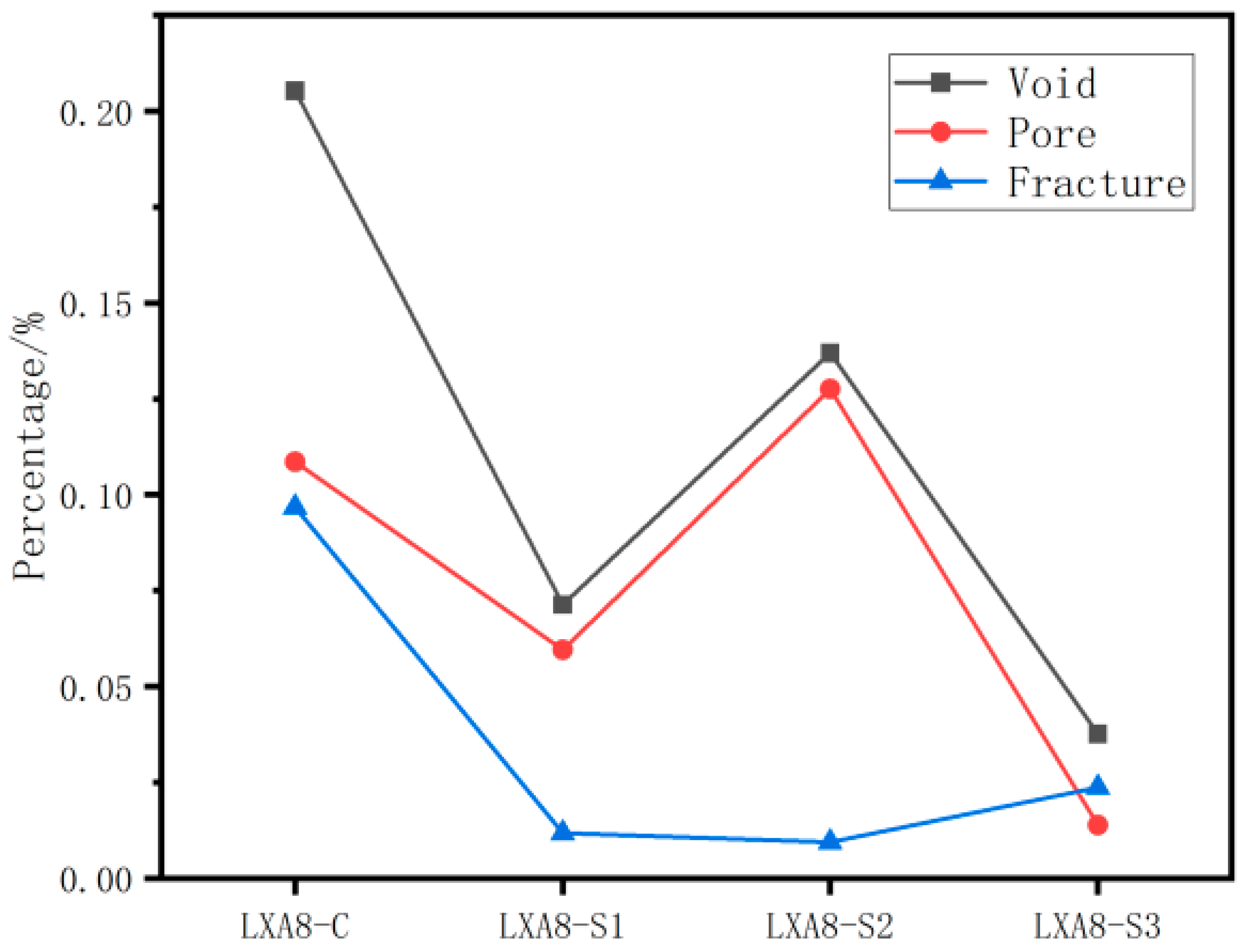
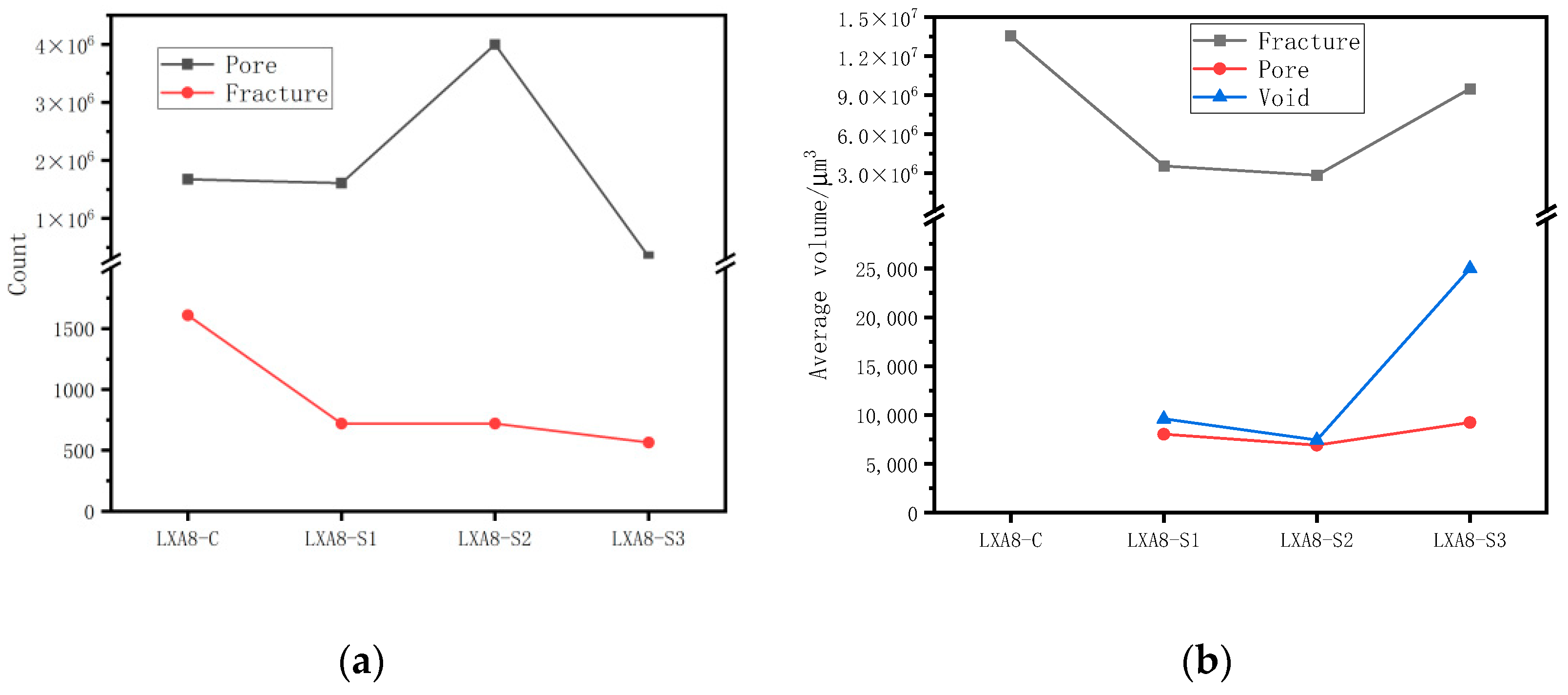
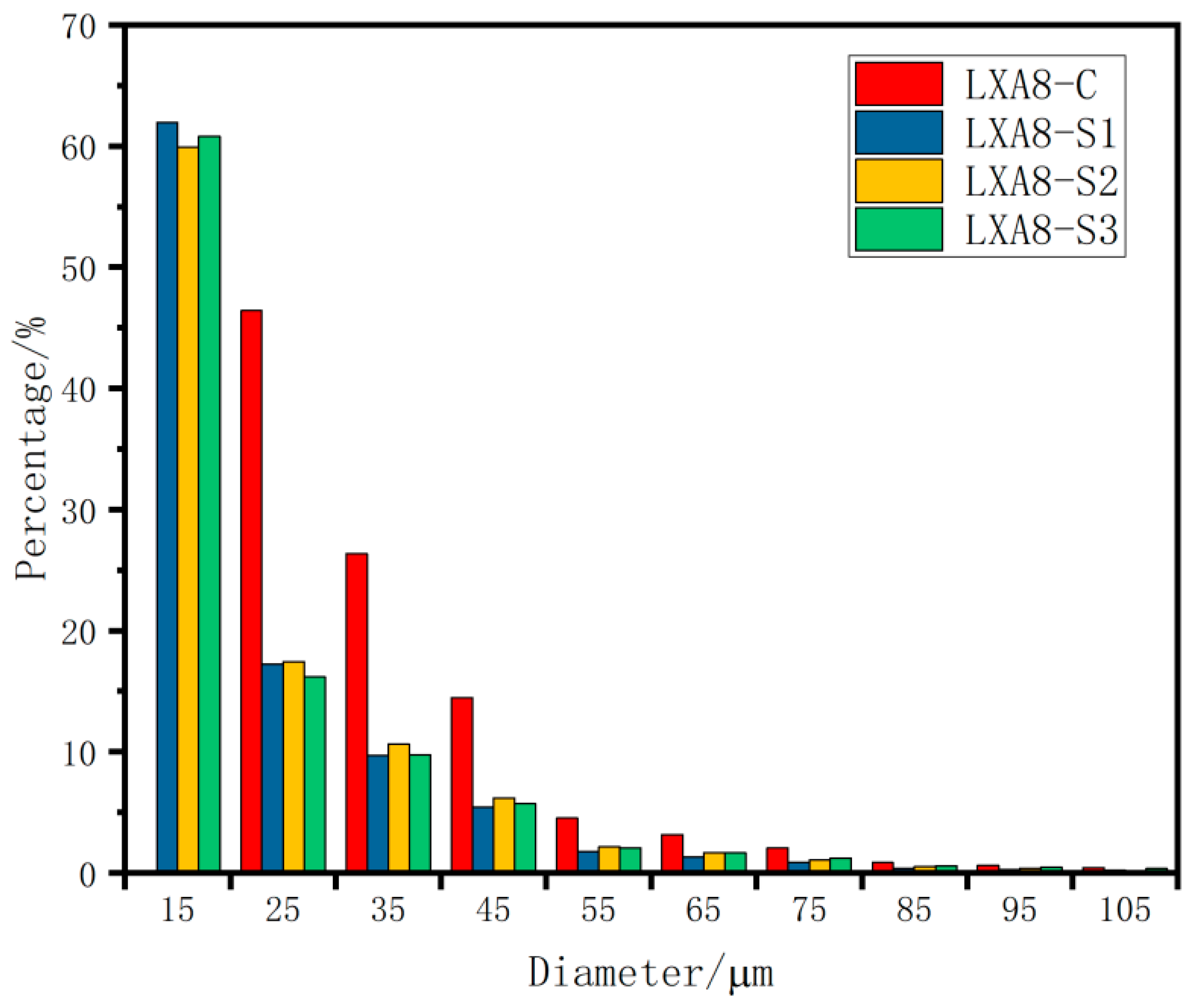
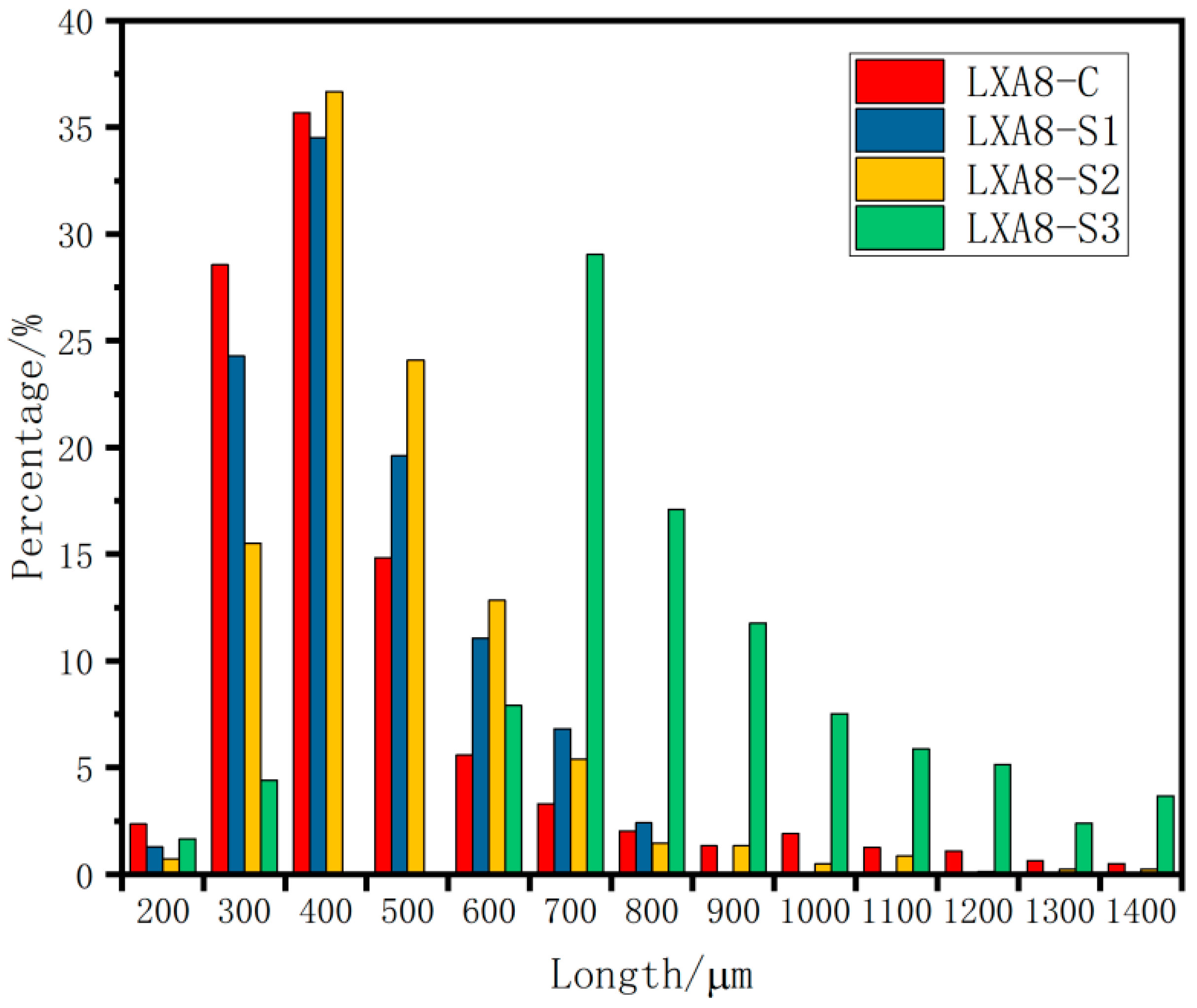

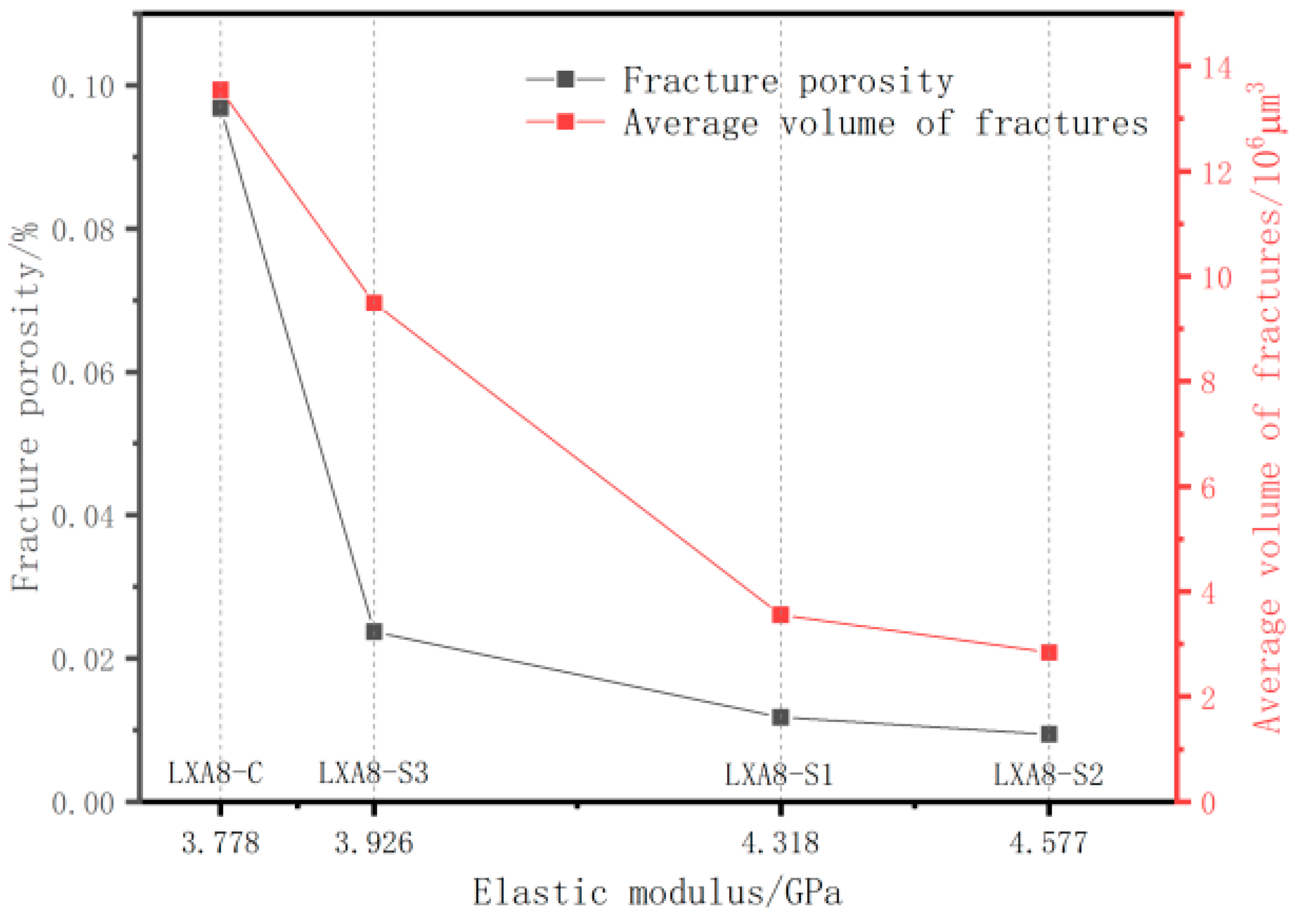
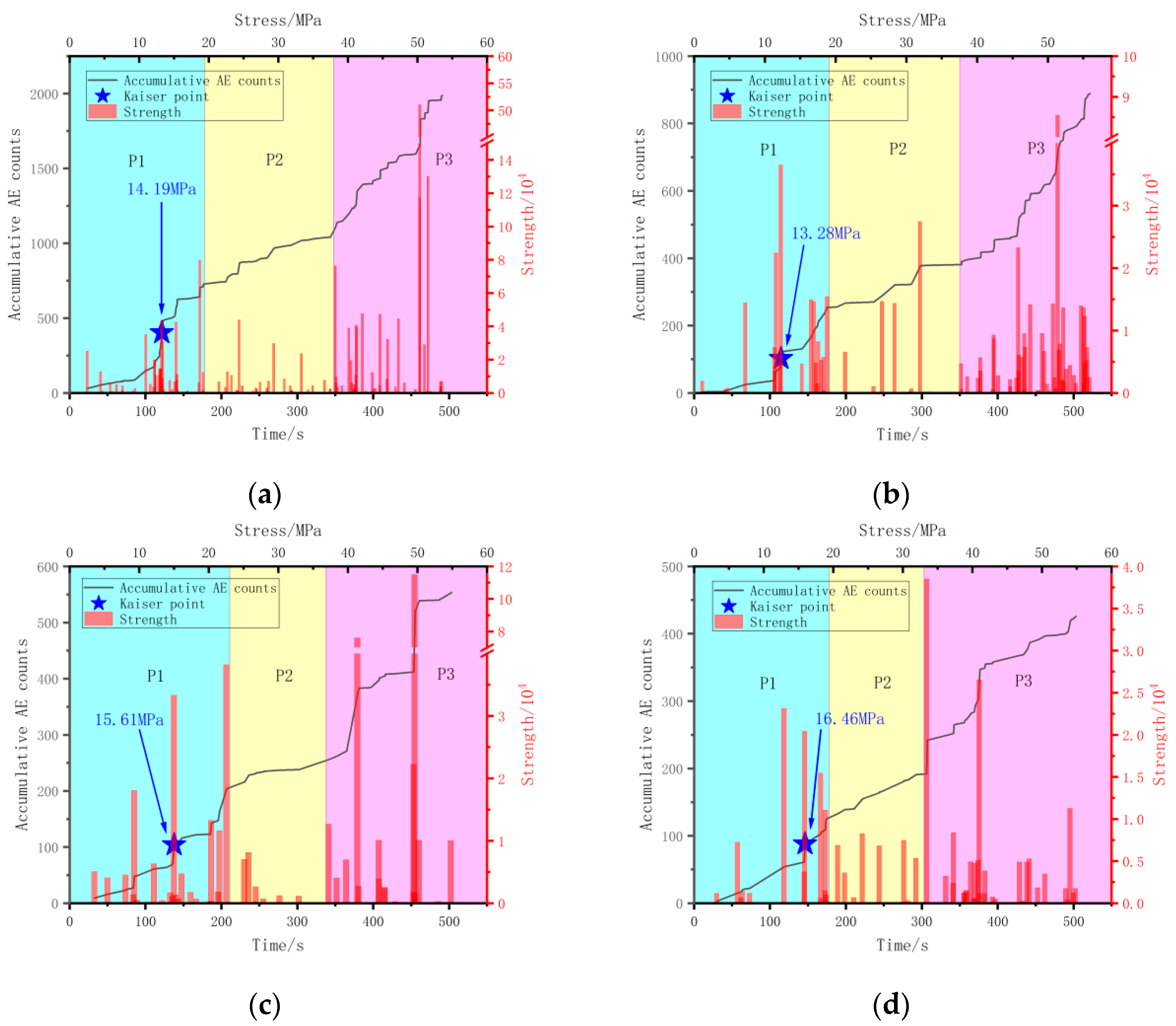
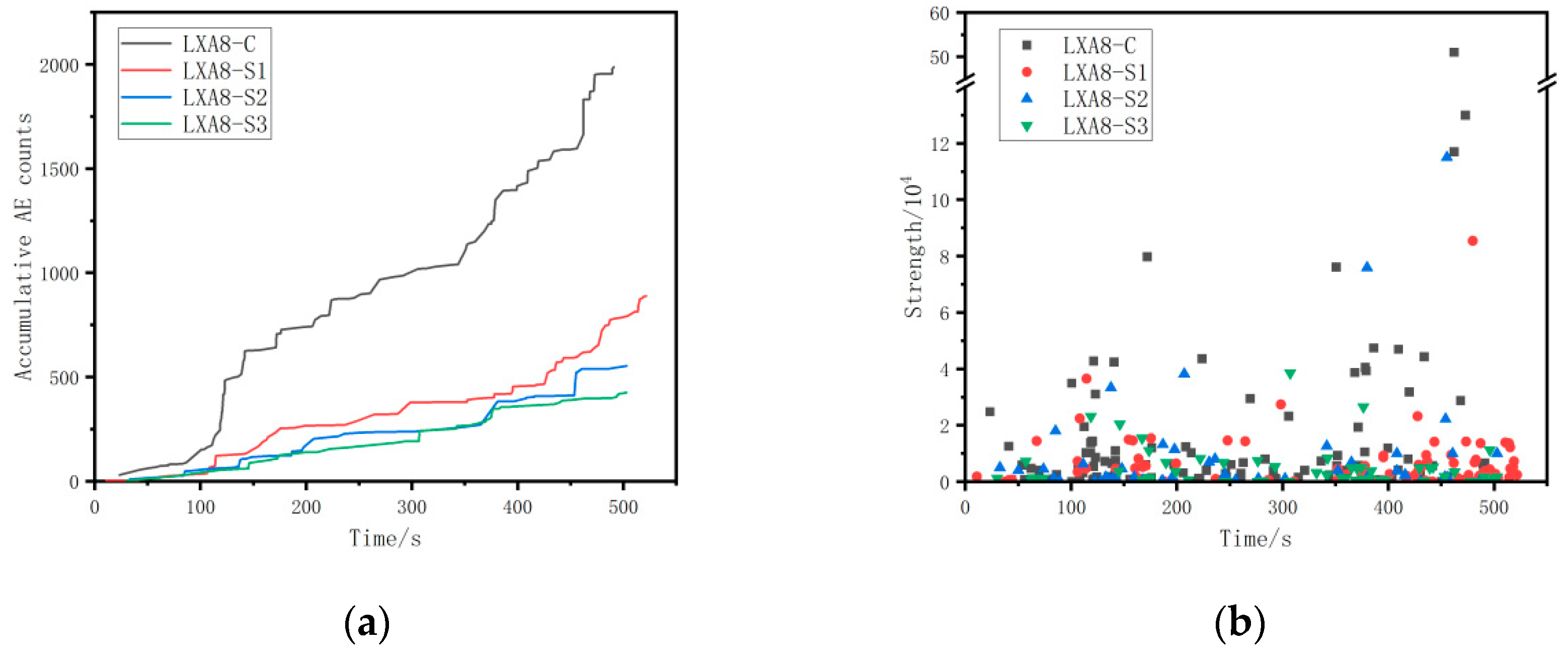
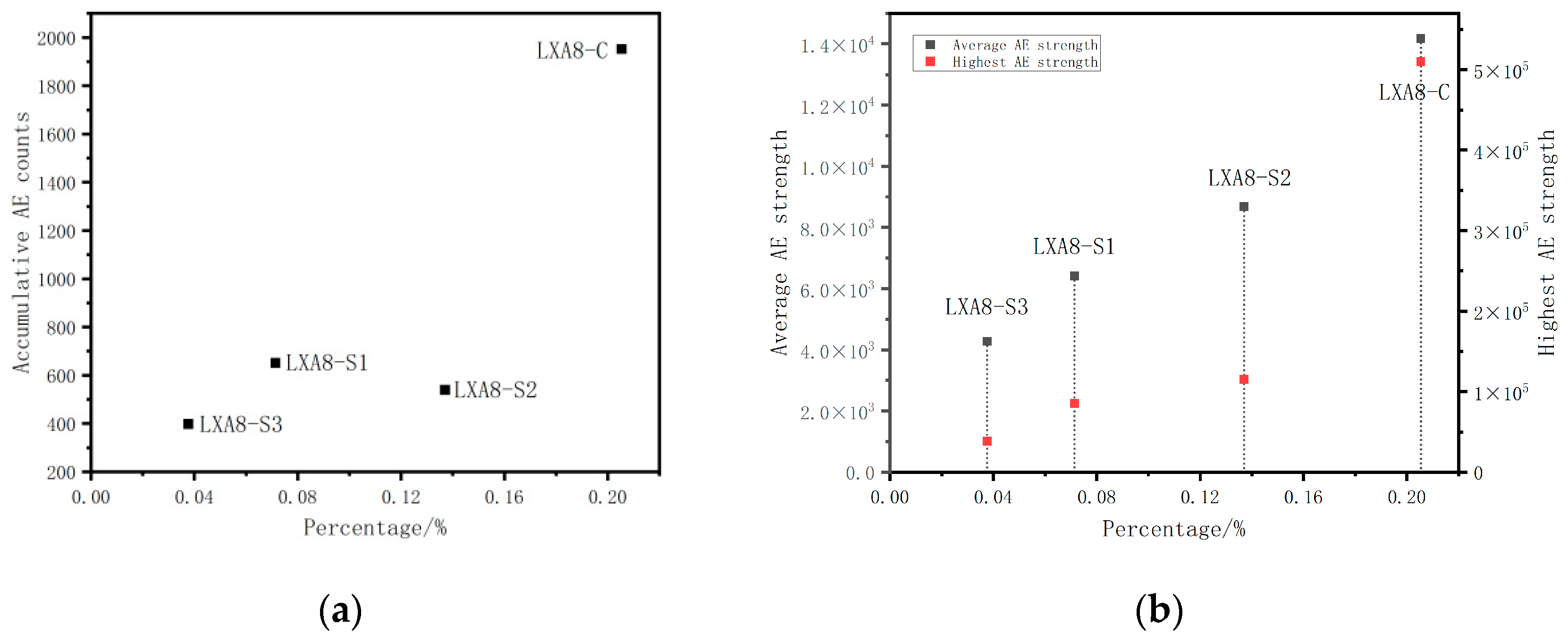
| Sample | Mad/% | Ad/% | Vd/% | FCd/% |
|---|---|---|---|---|
| LXA8 | 0.52 | 36.94 | 13.43 | 49.63 |
| Sample | Pore Number | Fracture Number | Pore Percentage/% | Fracture Percentage/% | Void Percentage/% | Average Pore Volume/μm3 | Average Fracture Volume/μm3 | Average Void Volume/μm3 |
|---|---|---|---|---|---|---|---|---|
| LXA8-C | 1,675,373 | 1609 | 0.1086 | 0.0968 | 0.2054 | 13,191 | 13,543,795 | 27,549 |
| LXA8-S1 | 1,608,971 | 720 | 0.0596 | 0.0118 | 0.0714 | 8044 | 3,559,431 | 9604 |
| LXA8-S2 | 3,999,514 | 720 | 0.1276 | 0.0094 | 0.1370 | 6925 | 2,839,164 | 7434 |
| LXA8-S3 | 338,556 | 564 | 0.0139 | 0.0237 | 0.0376 | 9226 | 9,488,337 | 24,976 |
| Sample | LXA8-C | LXA8-S1 | LXA8-S2 | LXA8-S3 |
|---|---|---|---|---|
| Modulus of elasticity/GPa | 3.778 | 4.318 | 4.577 | 3.926 |
| Vertical Principal Stress/MPa | Maximum Horizontal Principal Stress/MPa | Minimum Horizontal Principal Stress/MPa |
|---|---|---|
| 4.19 | 6.62 | 3.12 |
| Sample | Number of Large Fractures | Acoustic Emission Accumulative Count (in 50 MPa) | ||
|---|---|---|---|---|
| 0.01~0.1 mm3 | 0.1~1 mm3 | >1 mm3 | ||
| LXA8-C | 36 | 4 | 5 | 1952 |
| LXA8-S1 | 12 | 4 | 0 | 651 |
| LXA8-S2 | 15 | 0 | 0 | 540 |
| LXA8-S3 | 148 | 1 | 0 | 398 |
Disclaimer/Publisher’s Note: The statements, opinions and data contained in all publications are solely those of the individual author(s) and contributor(s) and not of MDPI and/or the editor(s). MDPI and/or the editor(s) disclaim responsibility for any injury to people or property resulting from any ideas, methods, instructions or products referred to in the content. |
© 2024 by the authors. Licensee MDPI, Basel, Switzerland. This article is an open access article distributed under the terms and conditions of the Creative Commons Attribution (CC BY) license (https://creativecommons.org/licenses/by/4.0/).
Share and Cite
Liu, X.; Zhang, S.; Xie, Y.; Wang, T. Three-Dimensional Heterogeneity of the Pore and Fracture Development and Acoustic Emission Response Characteristics of Coal Rocks in the Yunnan Laochang Block. Energies 2024, 17, 1207. https://doi.org/10.3390/en17051207
Liu X, Zhang S, Xie Y, Wang T. Three-Dimensional Heterogeneity of the Pore and Fracture Development and Acoustic Emission Response Characteristics of Coal Rocks in the Yunnan Laochang Block. Energies. 2024; 17(5):1207. https://doi.org/10.3390/en17051207
Chicago/Turabian StyleLiu, Xingzhi, Songhang Zhang, Yongkang Xie, and Tao Wang. 2024. "Three-Dimensional Heterogeneity of the Pore and Fracture Development and Acoustic Emission Response Characteristics of Coal Rocks in the Yunnan Laochang Block" Energies 17, no. 5: 1207. https://doi.org/10.3390/en17051207





